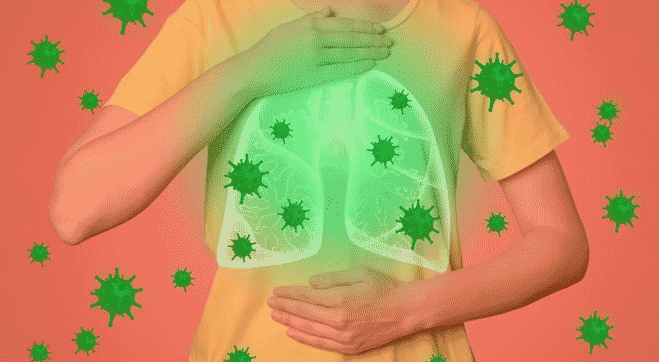TB can affect any part of the body. Tuberculosis (TB) being an airborne infection, is caused by the bacteria Mycobacterium tuberculosis (MTB). It is transmitted through the droplet nuclei containing the bacteria and are emitted by a patient suffering from active pulmonary TB. It is symptomized by sudden weight loss, coughing out blood with or without mucus, fever and night sweats.
Depending on the pathophysiology and body’s reaction to the bacterium, TB can be active (transmissible form where the host shows classic symptoms) or latent (dormant but viable bacterium is sequestered within lesions formed in the lungs).
People who consider TB as a lung disease, get astonished after hearing about someone suffering from abdominal TB or TB of joints. Yet, in addition to pulmonary TB, another form of TB is Extrapulmonary Tuberculosis (EPTB) which affects the organs other than lungs. In India, of all TB cases between 15-20% are of EPTB in immunocompetent individuals while 50% of HIV infected patients suffer from Extrapulmonary Tuberculosis.
Tuberculosis: Traveling Beyond Lungs
Pulmonary TB is characterized by lung infection and the pathogenesis
starts as soon as the bacilli reach the alveoli and replicate within the
localized macrophages. These cells interact with T lymphocytes and
differentiate into histocytes that aggregate along with lymphocytes
and form the granulomas which are the characteristics of TB. Those
at greatest risks are, people with altered cell immunity, those
suffering from malnutrition, HIV infected patients, the very young
and the very old as well as those with end-stage renal disease and
diabetes.
Extrapulmonary Tuberculosis occurs in 10-42% of adult TB patients depending on race or ethnic background, age, presence or absence of underlying disease, genotype of the Mycobacterium strain, and immune status. The lung being the primary site of infection, Extrapulmonary Tuberculosis infection initiates when the bacilli gain access to other regions of the body through blood or lymphatic system. EPTB may present with constitutional symptoms such as fever, anorexia, unexpected weight loss, malaise and fatigue. Additional symptoms are dependent on the organ and systems affected. The most common forms of Extrapulmonary Tuberculosis include lymphatic, pleural, bone and joint disease. Pericardial, meningeal and disseminated TB have greater rates of fatal outcome.
Different Organs Affected By Tuberculosis
- Lymph Node TB- It is the most common form of EPTB seen in India and considered as the local presentation of a systemic disease. It occurs when the bacteria spreads to the lymphs, with hilar and mediastinal lymph nodes involvement. It can occur during primary infection or reinfection post latency. It mostly manifests as enlarged lymph nodes.
- Tuberculous Pleural Effusion- Pleural effusion is the build-up of fluid in the lungs and the presence of inflammatory cells in the pleural space. It is one of the most common forms of EPTB, predominant in men, and manitests as tever, cough and chest pain.
- Bone and Joint TB-It affects spine, long bones and the joints. Infrequently, tuberculous bacilli travel from the lung to the spine along the Batson paravertebral venous plexus or by lymphatic drainage to the para aortic lymph nodes. The symptoms often progress over weeks and months, accompanied with back pain occasionally associated with abdominal pain.
- Abdominal TB-It includes TB of the gastrointestinal tract, peritoneum and intra-abdominal organs including liver, spleen and pancreas. Hepatobiliary and pancreatic TB are seen more often in immunocompromised individuals and manifest as anorexia, malaise, low grade fever, night sweats and obstructive jaundice. Splenomegaly is seen in patients with disseminated TB.
Other forms of Extrapulmonary Tuberculosis include pericardial TB, genitourinary TB, female genital TB, larynx TB, etc.
Diagnosing the Contagion!
Diagnostic algorithm has been shown below. Apart from this standard approach, ultrasound
scan, Computed Tomography (CT) and Magnetic Resonance Imaging (MRI) can be used for
precise localization of EPTB lesions. MRI and CT can be used to demonstrate edema, hydrocephalus,
and tuberculomas. Histopathological diagnosis or Fine Needle Aspiration Cytopathology (FNAC) are
considered as more sensitive procedures. It is relatively simple, less expensive and rapid technique
for diagnosing EPTB.
Managing It Right!
Therapy for managing Extrapulmonary Tuberculosis is similar to the regimens prescribed for
pulmonary TB. The commonly used anti- TB drugs include isoniazid,
rifampicin, ethambutol and pyrazinamide which are prescribed by
the doctor on six to nine month regimens, unless the infected
organism is suspected to be resistant to first line drugs. Patients with
TB meningitis, TB pericarditis and disseminated TB can also be
treated with adjunctive corticosteroids.
Surgery can also be required in individuals suffering from EPTB, mostly for diagnostic purposes (biopsies) and in some cases, as therapeutic options because of certain complications or sequelae arising from the disease.
Resistant Ones, Need a Control!
Data regarding drug resistance patterns in Extrapulmonary Tuberculosis and treatment
outcomes is limited for several reasons, including difficulty in
obtaining extrapulmonary specimens for analysis, and limited
facilities for testing these samples.
HIV patients who have been co-infected with Extensively Drug Resistant TB (XDR-TB) and EPTB have high mortality rates (without treatment -100%). Surgical resectioning and drainage in case of empyema, abscesses and arthritis could decrease bacterial burden and improve treatment outcome. However, for other types of Extrapulmonary Tuberculosis like TB meningitis, treatment is more challenging due to incomplete penetrance to cerebrospinal fluid of many second line drugs. Despite this, several studies report successful treatment of multidrug resistant TB with second line anti-TB drugs.
Prompt diagnosis and effective treatment are the only solutions to curb the emergence and spread of drug resistance
Doctors prescriptions and medications form only one half of disease management – without strict patient adherence to the treatments prescribed, further complications are bound to arise, such as emergence of multi-drug resistant strains. Being aware of the complications associated with a disease and getting timely diagnosis for it are also important aspects of disease prevention and management.








